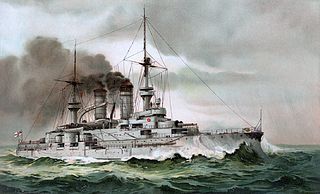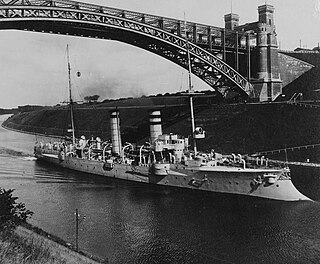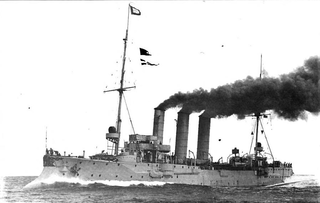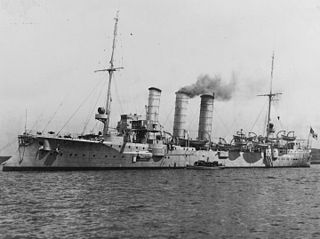
SMS Mainz was a Kolberg-class light cruiser of the German Kaiserliche Marine during the First World War. She had three sister ships, SMS Kolberg, Cöln, and Augsburg. She was built by the AG Vulcan shipyard in Stettin; her hull was laid down in 1908 and she was launched in January 1909. She was commissioned into the High Seas Fleet in October 1909. She was armed with a main battery of twelve 10.5 cm SK L/45 guns and had a top speed of 25.5 kn.

SMS Hela was an aviso built for the German Kaiserliche Marine in the mid-1890s, the last vessel of that type to be built by the German Empire. As the culmination of the type in German service, she represented significant improvements over earlier vessels, particularly the Wacht and Meteor classes, which had been disappointments in service. She was intended to serve as a fleet scout and as a flotilla leader for torpedo boats. Hela marked a step toward the development of the light cruiser. Armed with a battery of four 8.8 cm (3.5 in) guns and three 45 cm (17.7 in) torpedo tubes, the ship proved to be too weakly-armed for front-line combat.

SMS Zähringen was the third Wittelsbach-class pre-dreadnought battleship of the German Imperial Navy. Laid down in 1899 at the Germaniawerft shipyard in Kiel, she was launched on 12 June 1901 and commissioned on 25 October 1902. Her sisters were Wittelsbach, Wettin, Schwaben and Mecklenburg; they were the first capital ships built under the Navy Law of 1898, brought about by Admiral Alfred von Tirpitz. The ship, named for the former royal House of Zähringen, was armed with a main battery of four 24 cm (9.4 in) guns and had a top speed of 18 knots.

SMS Frauenlob was the eighth member of the ten-ship Gazelle class of light cruisers that were built for the German Kaiserliche Marine in the late 1890s and early 1900s. The Gazelle class was the culmination of earlier unprotected cruiser and aviso designs, combining the best aspects of both types in what became the progenitor of all future light cruisers of the Imperial fleet. Built to be able to serve with the main German fleet and as a colonial cruiser, she was armed with a battery of ten 10.5 cm (4.1 in) guns and a top speed of 21.5 knots. Frauenlob was a modified version of the basic Gazelle design, with improved armor and additional coal storage for a longer cruising range.

SMS Undine was the last member of the ten-ship Gazelle class of light cruisers that were built for the German Kaiserliche Marine in the late 1890s and early 1900s. The Gazelle class was the culmination of earlier unprotected cruiser and aviso designs, combining the best aspects of both types in what became the progenitor of all future light cruisers of the Imperial fleet. Built to be able to serve with the main German fleet and as a colonial cruiser, she was armed with a battery of ten 10.5 cm (4.1 in) guns and had a top speed of 21.5 knots. Undine was a modified version of the basic Gazelle design, with improved armor and additional coal storage for a longer cruising range.

SMS Stettin was a Königsberg-class light cruiser of the Kaiserliche Marine. She had three sister ships: Königsberg, Nürnberg, and Stuttgart. Laid down at AG Vulcan Stettin shipyard in 1906, Stettin was launched in March 1907 and commissioned into the High Seas Fleet seven months later in October. Like her sisters, Stettin was armed with a main battery of ten 10.5 cm (4.1 in) guns and a pair of 45 cm (18 in) torpedo tubes, and was capable of a top speed in excess of 25 knots.

SMS Wittelsbach was the lead ship of the Wittelsbach class of pre-dreadnought battleships, built for the Imperial German Navy. She was the first capital ship built under the Navy Law of 1898, brought about by Admiral Alfred von Tirpitz. Wittelsbach was laid down in 1899 at the Wilhelmshaven Navy Dockyard and completed in October 1902. She was armed with a main battery of four 24 cm (9.4 in) guns and had a top speed of 18 knots.

SMS Wettin was a pre-dreadnought battleship of the Wittelsbach class of the German Kaiserliche Marine. She was built by Schichau Seebeckwerft in Danzig. Wettin was laid down in October 1899, and was completed October 1902. She and her sister ships—Wittelsbach, Zähringen, Schwaben and Mecklenburg—were the first capital ships built under the Navy Law of 1898. Wettin was armed with a main battery of four 24 cm (9.4 in) guns and had a top speed of 18 knots.

SMS Prinz Adalbert was an armored cruiser built in the early 1900s for the Imperial German Navy. She was named after Prince Adalbert of Prussia, former Commander-in-Chief of the Prussian Navy, and was the lead ship of her class.

SMS Königsberg was the lead ship of the Königsberg class of light cruisers, built for the German Kaiserliche Marine during World War I. She took the name of the earlier Königsberg, which had been destroyed during the Battle of Rufiji Delta in 1915. The new ship was laid down in 1914 at the AG Weser shipyard, launched in December 1915, and commissioned into the High Seas Fleet in August 1916. Armed with eight 15 cm SK L/45 guns, the ship had a top speed of 27.5 kn.

SMS Nürnberg was a Königsberg-class light cruiser built during World War I by Germany for the Imperial Navy. She had three sisters: Königsberg, Karlsruhe, and Emden. The ship was named after the previous light cruiser Nürnberg, which had been sunk at the Battle of the Falkland Islands. The new cruiser was laid down in 1915 at the AG Weser shipyard in Bremen, launched in April 1916, and commissioned into the High Seas Fleet in February 1917. Armed with eight 15 cm (5.9 in) SK L/45 guns, the ship had a top speed of 27.5 kn.

SMS Kolberg was a light cruiser of the German Kaiserliche Marine during the First World War, the lead ship of her class. She had three sister ships, SMS Mainz, Cöln, and Augsburg. She was built by the Schichau-Werke; her hull was laid down in early 1908 and she was launched later that year, in November. She was commissioned into the High Seas Fleet in June 1910. She was armed with a main battery of twelve 10.5 cm SK L/45 guns and had a top speed of 25.5 kn.

SMS Amazone was the sixth member of the ten-ship Gazelle class of light cruisers that were built for the German Kaiserliche Marine in the late 1890s and early 1900s. The Gazelle class was the culmination of earlier unprotected cruiser and aviso designs, combining the best aspects of both types in what became the progenitor of all future light cruisers of the Imperial fleet. Built to be able to serve with the main German fleet and as a colonial cruiser, she was armed with a battery of ten 10.5 cm (4.1 in) guns and a top speed of 21.5 knots.

SMS Hamburg was the second member of the seven-vessel Bremen class of light cruisers, built for the German Kaiserliche Marine in the early 1900s. She and her sister ships were ordered under the 1898 Naval Law that required new cruisers be built to replace obsolete vessels in the fleet. The design for the Bremen class was derived from the preceding Gazelle class, utilizing a larger hull that allowed for additional boilers that increased speed. Named for the city of Hamburg, the ship was armed with a main battery of ten 10.5 cm (4.1 in) guns and had a top speed of 22 knots.

SMS Lübeck was the fourth of seven Bremen-class cruisers of the Imperial German Navy, named after the city of Lübeck. She was begun by AG Vulcan Stettin in Stettin in 1903, launched in March 1904 and commissioned in April 1905. Armed with a main battery of ten 10.5 cm (4.1 in) guns and two 45 cm (18 in) torpedo tubes, Lübeck was capable of a top speed of 22.5 knots.

SMS München was the fifth of seven Bremen-class cruisers of the Imperial German Navy, named after the city of Munich. She was built by AG Weser in Bremen, starting in 1903, launched in April 1904, and commissioned in January 1905. Armed with a main battery of ten 10.5 cm (4.1 in) guns and two 45 cm (18 in) torpedo tubes, München was capable of a top speed of 22.5 knots.

SMS Berlin was the second member of the seven-vessel Bremen class of light cruisers, built for the German Kaiserliche Marine in the early 1900s. She and her sister ships were ordered under the 1898 Naval Law that required new cruisers be built to replace obsolete vessels in the fleet. The design for the Bremen class was derived from the preceding Gazelle class, utilizing a larger hull that allowed for additional boilers that increased speed. Named for the German capital of Berlin, the ship was armed with a main battery of ten 10.5 cm (4.1 in) guns and had a top speed of 22 knots.
SMS Stuttgart was a Königsberg-class light cruiser of the Kaiserliche Marine, named after the city of Stuttgart. She had three sister ships: Königsberg, Nürnberg, and Stettin. Stuttgart was laid down at the Imperial Dockyard in Danzig in 1905, launched in September 1906, and commissioned in February 1908. Like her sisters, Stettin was armed with a main battery of ten 10.5 cm (4.1 in) guns and a pair of 45 cm (18 in) torpedo tubes, and was capable of a top speed in excess of 25 knots.

SMS Blitz was an aviso of the German Kaiserliche Marine built in the early 1880s. She was the lead ship of her class, which included one other vessel, SMS Pfeil. Her primary offensive armament consisted of a bow-mounted torpedo tube, and she was armed with a battery of light guns to defend herself against torpedo boats, a sign of the growing importance of torpedoes as effective weapons in the period. The Blitz class featured a number of innovations in German warship design: they were the first steel hulled warships and the first cruiser-type ships to discard traditional sailing rigs.





















